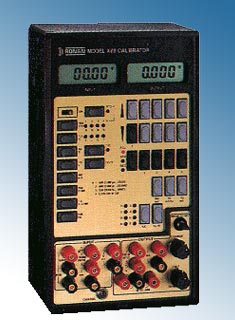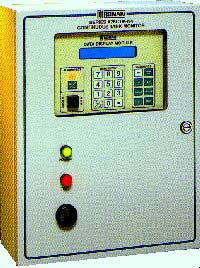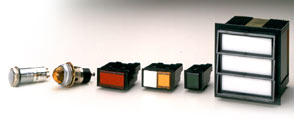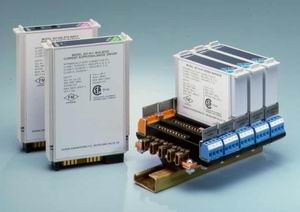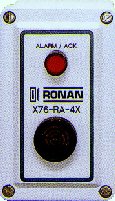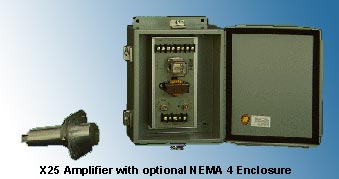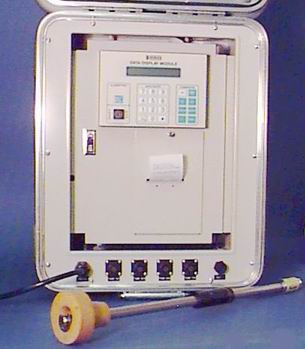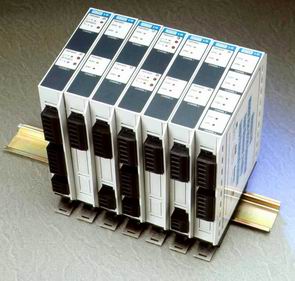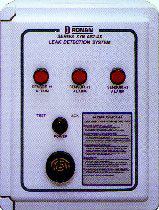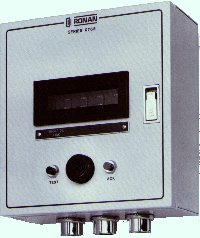* Ronan -Probes and Detectors

Aspiration Vapor Sensor HVFS

Discriminating LD Sensor [LS-4]
![Discriminating LD Sensor [LS-4]](../resimler/LD Sensör Ayırıcı [LS-4].jpg)
Description
A sensor designed to monitor secondary containment trench liners and containment sumps. Complies with NFPA 70 for use in Class 1 Division 1 hazardous locations and provide continuous monitoring and/or leak detection of secondarily contained storage systems capable of providing positive shutdown or lockout of product pumps or alarm annunciation when a leak is detected.
Hardware
- An discriminating intrinsically safe sensor and interface consisting of the following:
- Two or four inch mounted junction box with Class 1, Group C & D; Class 2, Groups E. F & G; Class 3 and NEMA 4 rating
- Discriminating vertical liquid sensor assembly consisting of:
- 304 stainless steel mounting fixture, 2" and 3" risers
- 316 stainless steel stem
- 316 stainless steel float, 1.8" diameter, 0.7 specific gravity
- anti-meniscus, 316 stainless steel, float stop
- 1/2" female NPT termination or cord grip
- magnetically actuated, hermetically sealed, SPST reed switches rated at 20VA
- Class 1, Division 1, Group C & D; Class 1, Division 2, Groups A, B, C & D rated when used in conjunction Ronan X76 series system with intrinsically safe extensions
- Operating temperature range -40° F to +300° F
- Operating pressure range 400 psig maximum
- Re-useable field terminals
- All components are Underwriters Laboratories (UL) Listed or Recognized
- Leak detection level sensor capable of the following:
- Detecting a breach in the primary containment discriminating between product or water:
- intrusion of product and/or water into the containment zone or sump
- trench liner containment
- Detecting the intrusion of product or water into containment sumps, trench liner and discriminating between the two capable of being functionally tested without sensor damage.
- Detecting a breach in the primary containment discriminating between product or water:
Operating Capabilities
- Continuously monitor liquid level
- The ability to provide automatic shutdown of controlled pumps
- The ability to provide alarm annunciation
- N.C. logic
- Fail-safe design
- Detect the presence of product and water
- Reusable, non-destructive actuation
- Discriminating between product or water
Explosion Proof Sensör LD [LS-6]
![Explosion Proof Sensör LD [LS-6]](../resimler/Explosion Proof Sensör LD [LS-6].jpg)
A sensor designed to monitor dispenser containment pans and high lever overfill protection and comply with NFPA 70 for use in Class 1 Division 1 hazardous locations and provide continuous monitoring and/or leak detection of secondarily contained storage systems capable of providing positive shutdown or lockout of product pumps or alarm annunciation when a leak is detected.
Hardware
- An explosion proof rated junction box, DPDT interface relay and sensor consisting of the following:
- Cast aluminum, explosion proof junction box with Class 1, Group C & D; Class 2, Groups E. F & G; Class 3 and NEMA 4 rating
- DPDT interface relay rated at 240VAC, 12A; coil 120VAC 50/60Hz
- Vertical liquid sensor assembly consisting of:
- 304 stainless steel housing, 3" x 1.310" ± 0.1"
- 316 stainless steel stem
- 316 stainless steel float, 1.0" diameter, 0.7 specific gravity
- anti-meniscus, 316 stainless steel, float stop
- compression fit aluminum bushing with 3/4" x 3/4" male NPT
- magnetically actuated, hermetically sealed, SPST reed switch rated at 20VA
- Class 1, Division 1, Group C & D; Class 1, Division 2, Groups A, B, C & D rated
- Operating temperature range -40° F to +300°F
- Operating pressure range 400 psig maximum
- 30" 22AWG polymeric wire leads
- All components shall be Underwriters Laboratories (UL) Listed or Recognized
- Leak detection level sensor capable of the following:
- Detecting a breach of either the primary or secondary containment by sensing:
- intrusion of product and/or water into the containment zone or sump
- high level overfill conditions within product storage tanks
- Detecting the intrusion of product and/or water into dispenser containment pans & sumps capable of being functionally tested without sensor damage
- Detecting a breach of either the primary or secondary containment by sensing:
Operating Capabilities
- Continuously monitor liquid level
- The ability to provide automatic shutdown of controlled pumps
- The ability to provide alarm annunciation
- Selectable N.O. or N.C. logic
- Fail-safe design
- Detect the presence of product and water
- Reusable, non-destructive actuation
- Operating as a stand alone device or used in concert with an X76 series control panel or monitor
Oil/Water High Level Sensor HLS-2

Ronan Engineering’s Model HLS-2 Custom Oil/Water High Level Sensor is designed to monitor fluid levels within oil/water separators. Constructed of stainless steel or brass, PVC, polysulfone, nitrile and beryllium copper, the HLS-2 Sensor will provide years of trouble-free service.
The HLS-2 is installed into the primary tank to provide discrete indications of high oil level and high water levels. Liquid levels sufficient to move the sensor’s float will transmit a signal to the control panel to initiate control functions or annunciate alarms.
Typical applications for the HLS-2 are oil/water separator high level sensing, and high level/overfill monitoring.
FEATURES
- Custom Lengths
- Variety of Materials
- 1/8" NPT to 2" NPT Mounts
- 3-5/8" Flange Mount
- Custom S.G.
- One to Six Discrete Level Points
The HLS-2 is available with a fixed or adjustable mounting for easy periodic testing or future adjustment. The sensor is installed through an available bung at the tank top. The HLS-2 may be supplied with a variety of logic configurations and for a variety of liquid densities. The standard HLS-2 is supplied with N.C. logic for fail-safe operation.
Specifications
- Wetted Parts: Stainless steel or brass; polypropylene, polysulfone, nitrile, beryllium copper, PVC
- Mounting: 1/8" to 2" NPT male or 3-5/8" flange
- Switch Rating: SPST or SPDT, 20VA, 120-240Vac pilot duty
- Operating: -40ºF to +300ºF maximum Temperature: (determined by float material)
- Float S.G.: 0.51 to 0.88
- Pressure: 500 psi maximum (determined by float material)
- Cable: Polymeric jacket wire pairs, 24" (18AWG 1-2 points, 22AWG 3-6 points)
Specifications are subject to change without notice. Contact Ronan Engineering to verify critical specifications
More Info PriceVapor Sensor HV

The HV Vapor Sensor, a solid state diffusion type, works on the absorption-desorption principle. The detection of a specific vapor is based on the absorption on the catalytic surface at a specific temperature. The gas absorption changes the resistance between the two electrodes embedded in the catalytic element. The resistance change is directly proportional to the vapor concentration and provides the input to the module. The vapor sensor, consisting of the sensing element contained within an anodized aluminum enclosure, is protected by the porous metal-fiber disc which serves as a flame arrestor. The sensor head assembly is UL listed for hazardous locations: Class I, Division 1, Groups B, C and D.
More Info Price
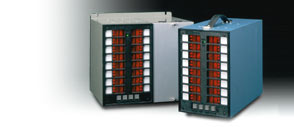


.jpg)



